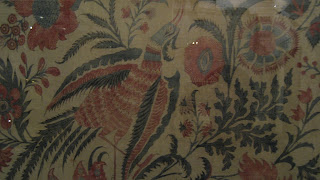Until last week I had never really visited Rome - only ever passed through. By chance when I did visit, the Palazzo Borghese it just happened to have a temporary exhibition on with a textile theme. Couture/Sculpture was a display of 65 stunning gowns and outfits set between the statues and the paintings. Text was sparse so you could only look and admire. The whole exhibition was the work of Tunisian born couturier and shoe designer, Azzedine Alaia.
I am not certain any of the items could have been worn - the effect appeared to be emphasise the sculptural and the dresses had the tiniest of waists. With all the other paintings and sculpture, it was difficult to know what to look at first - the art (especially Bernini), the architecture, the dresses. It seemed that I failed to pay attention to everything as I missed the stairs up to the first floor - just too many distractions.
The photographs I took show just some of the items on display, and a little of the permanent collection too. The painting behind this gown is a Caravaggio - "St Jerome Writing". Caravaggio is of course known for his use of light, and equally the dresses were enhanced by the way they were lit emphasising the curves and texture of the fabrics.
These next two reminded me of the recent Alexander McQueen exhibition at the V&A. One making use of what appears to be a whole alligator and the other with what appears to be suede and horse hair.
In the image above, I tried to capture the shadow, which added an extra dimension to the display.
These next two seemed particularly sculptural and elegant.
And lastly one of my favourites, with its intricate beadwork - which sadly I could not pick out, with only my camera phone at hand.
Sadly the exhibition has now closed - it finished the day after we visited.
While in Rome I threw a coin in the newly renovated Trevi Fountain, and if the legend is correct I will get back to for another visit some time. Next time I will pay more attention and ensure I visit the upstairs of any galleries I visit.






















